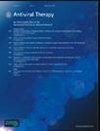单纯疱疹病毒在COVID-19合并急性呼吸窘迫综合征患者中的再激活:一项前瞻性队列研究
IF 2.3
4区 医学
Q4 INFECTIOUS DISEASES
引用次数: 3
摘要
背景在伴有急性呼吸窘迫综合征(ARDS)的严重新冠肺炎患者中,单纯疱疹病毒(HSV)再激活的发生率和危险因素资料匮乏。方法我们对一组严重急性呼吸系统综合征冠状病毒2型感染的ARDS患者进行了嵌套病例对照研究。2020年3月至4月期间,所有连续的机械通气患者均被纳入研究,这些患者年龄≥18岁,且粘膜样本中的严重急性呼吸系统综合征冠状病毒2型PCR呈阳性。我们收集了有关人口统计学、病史、实验室变量、抗病毒药物和其他药物的使用、呼吸和器官支持程序、微生物学结果以及俯卧位和类固醇使用的ARDS管理的数据。采用单变量和多变量Cox回归模型来确定HSV再激活的预测因素。结果83例实验室确诊的严重急性呼吸系统综合征冠状病毒2型感染者被送入重症监护室进行机械通气。18/83(21.7%)患者在中位17天后出现粘膜皮肤单纯疱疹病毒再激活(IQR,14-20)。俯卧位是HSV再激活的唯一独立危险因素(调整后的危险比,1.60;95%可信区间,1.11–2.30;P=0.009)。所有粘膜皮肤HSV再活化的患者都接受了抗病毒药物治疗。有和没有HSV再激活的患者在呼吸机相关肺炎、导管相关血流感染和住院死亡率方面的结果相似。结论新冠肺炎ARDS患者HSV再激活频繁,尤其是在需要长期俯卧位有创机械通气的情况下。在该人群中出现粘膜皮肤病变的情况下,应立即进行HSV检测并开始抗病毒治疗。本文章由计算机程序翻译,如有差异,请以英文原文为准。
Herpes simplex virus reactivation in patients with COVID-19 and acute respiratory distress syndrome: a prospective cohort study
Background There is a paucity of data about the occurrence and risk factors of herpes simplex virus (HSV) reactivation among patients with severe COVID-19 presenting with acute respiratory distress syndrome (ARDS). Methods We performed a nested case-control study among a cohort of SARS-CoV-2 infected patients with ARDS. Between March and April 2020, all consecutive mechanically ventilated patients ≥18 years old with a positive PCR for SARS-CoV-2 on mucocutaneous samples were included in the study. We collected data on demographics, medical history, laboratory variables, administration of antivirals and other agents, respiratory and organ support procedures, microbiological results, and management of ARDS with prone positioning and the use of steroids. Univariate and multivariable Cox regression models were performed in order to identify predictors of HSV reactivation. Results Eighty-three patients with laboratory-confirmed SARS-CoV-2 infection were admitted to the ICU for mechanical ventilation. 18/83 (21.7%) patients developed mucocutaneous herpes simplex virus reactivation after a median of 17 days (IQR, 14–20). Prone positioning was the only independent risk factor for HSV reactivation (adj. hazard ratios, 1.60; 95% CI, 1.11–2.30; P = 0.009). All patients with mucocutaneous HSV reactivation were treated with antivirals. The outcome in terms of ventilator-associated pneumonia, catheter-related bloodstream infections, and in-hospital mortality was similar for patients with and without HSV reactivation. Conclusions HSV reactivation is frequent in COVID-19 patients with ARDS, especially if prolonged invasive mechanical ventilation with prone positioning is needed. Prompt testing for HSV and initiation of antiviral therapy should be performed in case of mucocutaneous lesions in this population.
求助全文
通过发布文献求助,成功后即可免费获取论文全文。
去求助
来源期刊

Antiviral Therapy
医学-病毒学
CiteScore
2.60
自引率
8.30%
发文量
35
审稿时长
4-8 weeks
期刊介绍:
Antiviral Therapy (an official publication of the International Society of Antiviral Research) is an international, peer-reviewed journal devoted to publishing articles on the clinical development and use of antiviral agents and vaccines, and the treatment of all viral diseases. Antiviral Therapy is one of the leading journals in virology and infectious diseases.
The journal is comprehensive, and publishes articles concerning all clinical aspects of antiviral therapy. It features editorials, original research papers, specially commissioned review articles, letters and book reviews. The journal is aimed at physicians and specialists interested in clinical and basic research.
 求助内容:
求助内容: 应助结果提醒方式:
应助结果提醒方式:


